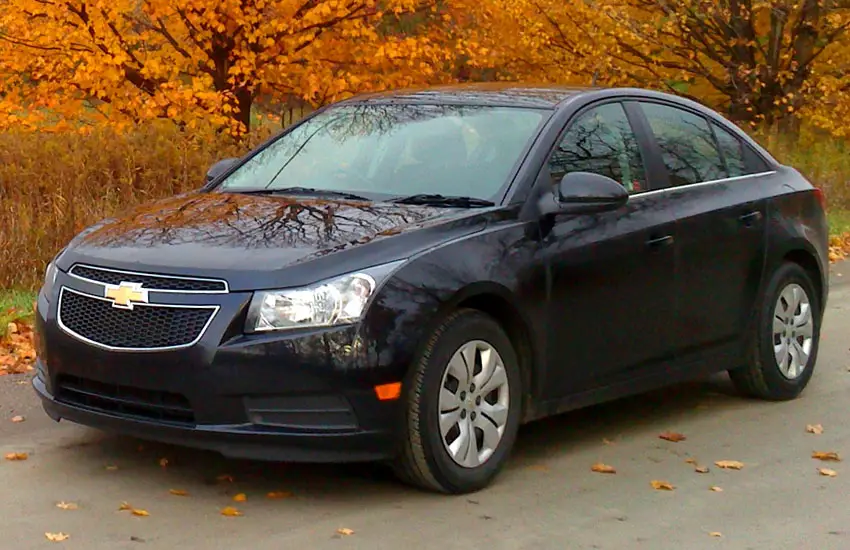As an Amazon Associate, I earn from qualifying purchases at no extra cost to you.
P1101 Chevy Cruze: Chevy Cruze Mass Air Flow Sensor [Fixed]
When your Chevy Cruze’s check engine light suddenly turns on, it could mean many things, but one of the most common reasons is an issue with the mass air flow (MAF) sensor. If you've come across the P1101 error code, it's important to understand its meaning and how to fix it. This code usually signals that something is wrong with the mass air flow sensor in your vehicle, affecting engine performance. Let's dive deep into what this code means and how to deal with it, step by step.
What Is a Mass Air Flow Sensor?
To truly understand the P1101 error code, it's essential to first understand the role of the mass air flow (MAF) sensor in your Chevy Cruze. The MAF sensor plays a crucial role in the vehicle's air intake system, monitoring the amount of air entering the engine. This data is vital for the engine control unit (ECU) to calculate the right amount of fuel to inject for optimal performance.
A malfunctioning MAF sensor can disrupt the fuel-to-air ratio in the engine, leading to poor performance, reduced fuel efficiency, or even engine damage over time. The sensor uses a heated wire or film that changes temperature as air passes through it.
The ECU uses these changes in temperature to calculate the amount of air entering the engine and adjusts the fuel injection accordingly. If the sensor provides incorrect data, it can cause the engine to run too rich (too much fuel) or too lean (too little fuel), which can affect your car's performance and lead to trouble codes like P1101.

What Does the P1101 Code Mean?
The P1101 code specifically refers to a “Mass Air Flow (MAF) Sensor Range/Performance” issue. This means that the ECU has detected an issue with the data being sent by the MAF sensor. More precisely, the engine control unit expects the MAF sensor to be within a certain range of values, but when these values fall outside the acceptable limits, it triggers the P1101 code. This could be due to a variety of reasons, including sensor malfunctions, wiring issues, or even problems with the air filter or intake system.
Possible Causes of the P1101 Code
A variety of issues can trigger the P1101 code. Understanding these causes can help you troubleshoot the problem and determine the best solution. Below are some of the most common reasons behind the P1101 code:
1. Faulty Mass Air Flow Sensor
The most obvious cause of a P1101 code is a malfunctioning MAF sensor itself. Over time, the sensor can wear out or become dirty, leading to inaccurate readings. When this happens, the ECU is unable to make the correct calculations for fuel delivery, and the P1101 code is triggered.
2. Dirty or Clogged Air Filter
If the air filter is clogged or dirty, it can restrict the flow of air entering the engine, affecting the MAF sensor's readings. A restricted airflow can lead to incorrect data being sent to the ECU, triggering the P1101 code.
3. Vacuum Leaks
Vacuum leaks in the intake manifold or the hoses connected to it can cause the air-fuel mixture to become unbalanced. This disruption can affect the readings from the MAF sensor and may cause the P1101 code to appear.
4. Wiring or Connection Problems
Another common reason behind the P1101 code is damaged or corroded wiring and connectors that are linked to the MAF sensor. If these wires are loose or corroded, they can cause an incorrect signal to be sent to the ECU, leading to performance issues and a trouble code.
5. Unmetered Air Entering the Engine
If air bypasses the MAF sensor, such as through a damaged or improperly installed air filter, it can lead to incorrect readings. The MAF sensor is designed to measure all the air entering the engine, and any unmetered air can cause problems in the air-fuel ratio, triggering the P1101 code.
6. Faulty ECU or Software
Though less common, a malfunctioning ECU or outdated software can sometimes be the culprit behind the P1101 error code. In this case, the ECU may not be able to properly process the data from the MAF sensor, causing the code to appear.
How to Diagnose the P1101 Code
When you see the P1101 code on your Chevy Cruze, you'll need to follow a series of diagnostic steps to pinpoint the exact cause of the issue. The right tools and knowledge can help you identify the problem and get your vehicle back in good working condition.
Step 1: Use an OBD-II Scanner
The first thing to do when you encounter a P1101 code is to use an OBD-II scanner to retrieve additional trouble codes. While P1101 provides a general indication that there's a problem with the MAF sensor, there may be other codes present that can give you more information about the issue. The OBD-II scanner will also provide real-time data, such as air intake temperature and MAF sensor voltage, which can help further pinpoint the cause of the problem.
Step 2: Inspect the MAF Sensor
If the scanner shows that the MAF sensor is the primary culprit, inspect the sensor itself. Check for any visible signs of damage, corrosion, or dirt buildup on the sensor. Cleaning the MAF sensor is often a quick and easy fix. You can use a specialized MAF sensor cleaner to remove dirt or oil that may have accumulated on the sensor. Be sure to handle the sensor gently, as it's quite delicate.
Step 3: Check the Air Filter
If the MAF sensor appears clean and undamaged, the next step is to inspect the air filter. A clogged or dirty air filter can restrict airflow and cause incorrect readings from the MAF sensor. Replacing a dirty air filter is an easy and inexpensive fix that can solve the problem.
Step 4: Inspect the Wiring and Connectors
Another step in the diagnosis process is to inspect the wiring and connectors that lead to the MAF sensor. Look for any loose connections, frayed wires, or corrosion. Damaged wires or connectors can lead to poor communication between the MAF sensor and the ECU, resulting in the P1101 code. If you find any issues, repair or replace the damaged components.
Step 5: Check for Vacuum Leaks
Vacuum leaks are another common cause of the P1101 code. Check the intake manifold, hoses, and connections for any signs of leaks. If you detect a vacuum leak, it can be sealed or repaired to restore proper air-fuel balance.
How to Fix the P1101 Code
Once you have diagnosed the problem, there are a few potential solutions for fixing the P1101 error code. Depending on the exact cause of the issue, you may need to replace the MAF sensor, clean the sensor, replace a damaged air filter, or fix wiring problems. Let's explore these solutions in detail.
1. Cleaning the MAF Sensor
One of the easiest fixes for the P1101 code is to clean the MAF sensor. Over time, dirt, dust, and oil can accumulate on the sensor, affecting its accuracy. You can purchase a specialized MAF sensor cleaner and follow the instructions to gently clean the sensor. Be sure to let the sensor dry completely before reinstalling it.
2. Replacing the MAF Sensor
If cleaning the MAF sensor doesn't solve the problem, you may need to replace it. MAF sensors can wear out over time, and replacing the sensor may be the only way to resolve the issue. Be sure to purchase a replacement sensor that is compatible with your Chevy Cruze.
3. Replacing the Air Filter
If a dirty air filter is the cause of the problem, replacing it is a quick and inexpensive solution. A clean air filter will allow the proper amount of air to reach the MAF sensor, improving its accuracy and restoring proper engine performance.
4. Repairing or Replacing Wiring
If the issue lies with damaged wiring or connectors, repairing or replacing the damaged components is necessary. Inspect the wiring carefully and use electrical tape or connectors to fix any frayed or broken wires. If the damage is extensive, you may need to replace the entire wiring harness.
5. Fixing Vacuum Leaks
If a vacuum leak is causing the P1101 code, you'll need to find and seal the leak. Vacuum leaks can sometimes be tricky to locate, but using a smoke machine or a simple spray of soapy water around the intake manifold and hoses can help you pinpoint the source of the leak.
I hope this article has helped you understand what the P1101 code means for your Chevy Cruze and how to fix the issues related to the mass air flow sensor. Whether it’s cleaning the sensor, replacing parts, or fixing wiring issues, you now have a better understanding of the steps involved in diagnosing and fixing this problem.
Are These Questions in Your Mind?
Can I drive my Chevy Cruze with the P1101 code?
If the P1101 code appears, it’s generally safe to drive your car for short distances. However, continued driving with the issue unresolved can lead to poor fuel economy, rough engine performance, and potential engine damage.
Is it expensive to replace a MAF sensor?
The cost of replacing a MAF sensor can vary. Typically, the part itself ranges from $100 to $300, depending on the brand and model. Labor costs can add an additional $50 to $150, depending on where you take the car for repairs.
Can a dirty air filter cause a P1101 code?
Yes, a dirty or clogged air filter can restrict airflow and lead to inaccurate readings from the MAF sensor, triggering the P1101 code.
Do I need to reset the ECU after fixing the P1101 code?
It is a good idea to reset the ECU after addressing the issue. This will allow the vehicle’s computer to recheck the system and verify that the problem has been resolved.
Can a vacuum leak trigger the P1101 code?
Yes, a vacuum leak can disrupt the air-fuel ratio, causing the MAF sensor to send incorrect data to the ECU, which can result in the P1101 code.
Is it safe to clean the MAF sensor myself?
Yes, cleaning the MAF sensor yourself is safe as long as you use a proper MAF sensor cleaner and follow the instructions carefully. Avoid touching the sensor directly, as it's fragile.
Can the P1101 code be caused by a malfunctioning ECU?
Although rare, a malfunctioning ECU or outdated software could be the cause of the P1101 code. In such cases, reprogramming or replacing the ECU may be necessary.
Do I need to replace the MAF sensor if it's throwing the P1101 code?
Not necessarily. Often, cleaning the MAF sensor can resolve the issue. However, if the sensor is damaged or worn out, replacement may be required.
Can a faulty fuel injector cause the P1101 code?
While a faulty fuel injector can cause engine performance issues, it is typically not directly related to the P1101 code, which is more commonly caused by MAF sensor issues.
Is it possible to diagnose the P1101 code without a scanner?
It is possible to perform a visual inspection, but a scanner will provide more accurate and detailed data about the issue, making diagnosis easier and more efficient.











